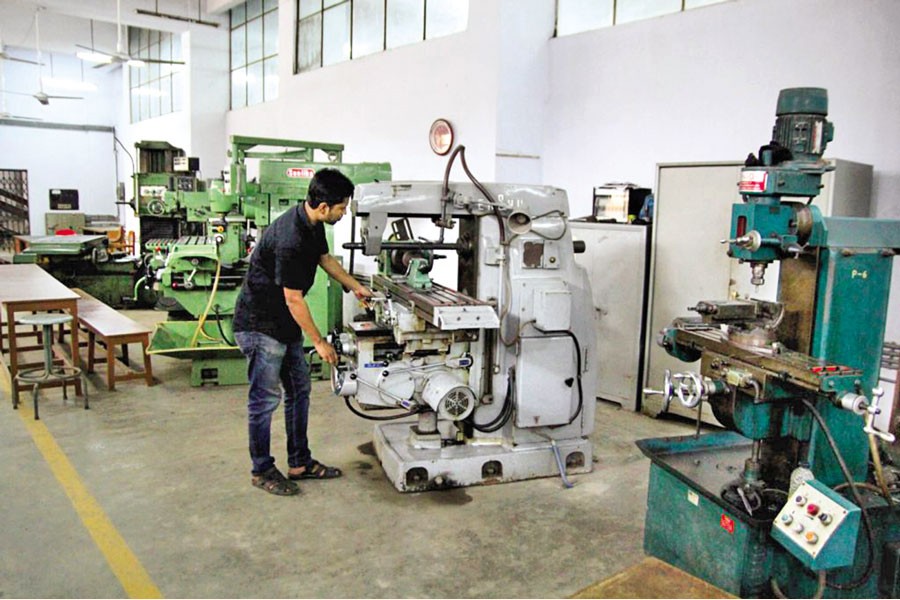
Higher education's role in shaping future of businesses: Industry-academia bond pays off
Mohammad A. Momen and Melita Mehjabeen | Wednesday, 24 November 2021

 The growth story of Bangladesh, across both economic and social development indicators, has been phenomenal over the last 50 years since independence. However, the country continues to face headwinds in future growth opportunities due to academic and vocational skills mismatch in the workforce. With the onset of the 4th industrial revolution, characterized by significant technological advances in transforming the world into a global village, automated, virtual, and flexible ecosystem, it is an imperative to ensure that our workforce is trained in specialized skills required in the global contest for jobs in the digital economy.
The growth story of Bangladesh, across both economic and social development indicators, has been phenomenal over the last 50 years since independence. However, the country continues to face headwinds in future growth opportunities due to academic and vocational skills mismatch in the workforce. With the onset of the 4th industrial revolution, characterized by significant technological advances in transforming the world into a global village, automated, virtual, and flexible ecosystem, it is an imperative to ensure that our workforce is trained in specialized skills required in the global contest for jobs in the digital economy.
Bangladesh has a population of around 165million - with a median age of only 27.6 years and more than 20 per cent of the total population aged 15-25 years (UNFPA)[1]. This positions the country at an inflection point where it has immense potential to transform this growing young population into a powerhouse of innovative and adaptive human resource through industry-focused education, thereby capturing the benefit of substantial demographic dividend for the coming decades. According to a study by Bangladesh Institute of Development Studies (BIDS), the graduate unemployment rate of Bangladesh was 33.19 per cent in 2019. This seems counterintuitive to the fact that the rapidly growing manufacturing and service sectors of the economy are experiencing acute shortage of skilled employees. The only plausible explanation for this anomaly is the mismatch between skills required by the industry and skills actually possessed by the graduates.
With the fast-paced dynamics of the economy, today's businesses are defined by uncertainty, complexity, and volatility. Most challenges facing businesses require unique and complex problem-solving skills with the use of data. Hence, ensuring business resilience in the wake of uncertainty and disruptions requires a new generation of business leaders equipped with a dynamic skillset and multidimensional outlook. These are leaders who are capable of identifying emerging risks and can successfully navigate through the uncertain business environment. In order to face the challenges, universities and other higher- education institutions in Bangladesh must align with the evolving contexts of leadership characterized by innovation, technology, globalization, and sustainability, which should be embedded in the curricular and co-curricular experiences of students. While technical skills remain critical -- including the ability to understand cause-and-effect relationship -- the contemporary leadership development should focus more on adaptive capacities. In this context, the emphasis should be more on real-time problem solving and decision-making under uncertainty.
One of the ways to develop such dynamic leaders is to create a collaborative ecosystem between industry and academia, which is reciprocal, mutually beneficial, and sustainable. This would ensure effectual knowledge transfer and prepare today's students for a business environment that, in many instances, doesn't yet exist. In order to ensure sustained economic growth momentum through attracting and retaining investments, both foreign and domestic, nothing can be more pertinent than developing a knowledge-based economy with seamless knowledge transfer between industry and academia.
Universities in other parts of the world are already reaping the benefits of such efforts for decades. One shining example is the collaboration between Silicon Valley firms and Stanford University. The Stanford Industrial Park, The Stanford Research Park was the original hub for some of the brightest minds of technology, linking academia and industry, with the goal of advancing tech knowledge. Not only that , world-renowned companies like Tesla, Skype, HP have their R&D labs inside the Stanford Research park, where the cutting- edge researches are conducted and later commercialized.
The industry-academia ecosystems of China and Korea through industry -- university joint graduate programmes, shared research facilities, and technology -- incubation programmes are also exemplary. These partnerships have resulted in successful commercialization of numerous academic ideas, research, and innovations. Most recently, the power of successful collaboration between industry and academia can be seen in the form of lifesaving Oxford AstraZeneca vaccine - one of the fastest developments in the history of medical science.
Currently, primary business schools and management education in Bangladesh have limited partnerships in the form of standard internship, full-time placement and academic project support or training and developing the executives. However, the universities need to rethink beyond these engagements. Private sector and academia should co-brand, co-create and co-deliver the curricular activities and take the engagement to the next frontier with an equal stake in the ecosystem. While curriculum and related activities have historically been the sole domain of academia, educational institutions should start bringing in the industry while designing curriculum in today's world where changes are fast and unprecedented. In fact, failure to anticipate the implications of pandemic and the subsequent adaptation to online education instead of traditional learning model was nothing but a failure of imagination.
Besides curricula and skills, the role of higher-education institutions (HEIs) in Bangladesh in producing high-quality exploitable research is more critical than ever. Conducting research that is both practically relevant and scientifically rigorous, while creating value for society, is a continuous challenge for scholars and academics. The government, policymakers, the trade bodies and associations and even the private sector should refer social and business issues to academia by making grants and funding available to conduct relevant research which addresses such critical issues.
While the government does have Skills Development and Higher Education Policies in place, implementation must be timely and effective so that Bangladesh can avail the benefits of its demographic dividend within its window of opportunity before it is too late.
While curriculum can be developed based on industry demand, access to education must also be taken into consideration. In 2019, only approximately 24-percent enrollment in Bangladesh was there in the tertiary education (BBS, 2019)[2] and 45 per cent of the tertiary enrollment was in private universities (World Bank, 2019)[3]. To develop the necessary skills among the young population who do not have access to tertiary education, use of technology is the most suitable channel.
While traditional four-year courses and degrees remain predominant, flexible certificate programmes delivered online or through hybrid channels will cater to the demands of such population seeking management education. On that note, it is an imperative to heavily invest in technological infrastructure in academia to ensure access to technology for all students. At the same time, investments need to be made in technological training and development. Effective investments in higher education can serve every country across the development spectrum through talent and leadership development. Subsequent real-life application of the acquired knowledge will address social, economic, and global challenges with increased participation in global knowledge economy.
The higher-education institutions (both public and private) and vocational and polytechnic institutes of Bangladesh should come forward to realize their roles in nurturing the future generations, who will be largely responsible for taking Bangladesh to the next level of a developed country by 2041. The higher-education institutions should be committed to imparting value- based quality education, coupled with inclusive development of students.
Prof. Mohammad A. Momen is the Director, IBA, the University of Dhaka, and Melita Mehjabeen, PhD (UK), is an Associate Professor at the DU IBA. Authors can be reached at
momen@iba-du.edu, and melitam@iba-du.edu.